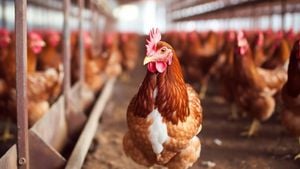Toronto is taking steps to manage its pigeon population with some innovative twists. The city has recently installed specialized bird feeders at key urban locations, including City Hall, Nathan Phillips Square, and the Waterfront, to dispense pigeon birth control. This initiative is part of a pilot program aimed at curbing the growing number of pigeons, which have often been labeled as pests due to their droppings, noise, and overpopulation issues.
This effort isn't just about reducing the number of pigeons; it's about finding humane and effective methods to control their population. Approximately 300 pigeons are currently being targeted as part of this initiative, which aims to lower their numbers sustainably without resorting to more harmful methods of control. The feeding stations utilize specially formulated feed laced with contraceptive agents, allowing the city to reduce the reproductive rate of these birds effectively. This means fewer eggs and, eventually, fewer pigeons flocking to urban spaces.
Public health and urban management experts have been vocal about the necessity of such approaches. Matthew Bingley, from Global News, highlighted the important balance between managing wildlife and maintaining humane treatment of these creatures. He stated, "It’s about finding ways to live with these birds instead of treating them as nuisances." This sentiment is echoed by various city officials who recognize the practical need to address the pigeon population responsibly, considering the potential impact on public health, as pigeon droppings can cause hygiene issues and even transmit diseases.
Under the guidance of city officials and animal welfare groups, the program has already demonstrated successes. Early results show promise, indicating the number of pigeons is stabilizing, and complaints from residents about excess droppings and noise have begun to decline. City officials remain hopeful and are exploring the possibility of making this program permanent due to its effectiveness.
The background to this initiative includes numerous complaints from Toronto residents about the increasing pigeon problem. Urban dwellers expressed frustration over the mess pigeons create—especially around highly trafficked areas like parks and public squares. The droppings not only tarnish the aesthetic appeal of the city but also present potential health hazards if not managed properly.
Initially launched as a trial, the project started with four feeders strategically placed across high-traffic areas. It uses safe methods of contraception, ensuring no harm to the birds or surrounding environment. The feed is not only nourishing to the birds but also contains the necessary contraceptive components to help regulate their breeding cycles. Toronto’s innovative approach places it at the forefront of urban wildlife management.
This program aligns with broader discussions within city governance about sustainable urban living. Toronto's Local Biodiversity Strategy aims to promote coexistence between urban communities and wildlife. These endeavors are also reflective of changing attitudes toward urban wildlife, moving from control and extermination methods to more sustainable coexistence strategies.
Councillor Bhabha, who spearheads this initiative, expressed excitement about its potential impact. "The goal is not just to decrease numbers but to create harmony between residents and wildlife. Managing our city's biodiversity is as important as managing urban life itself," they articulated, highlighting the program’s broader vision.
Community responses have been overwhelmingly positive, with many residents expressing relief over the reduction of nuisance complaints. Social media has seen posts from proud citizens sharing pictures of the new feeders and discussing their hopes for the future of pigeon management. These discussions indicate growing public support for humane wildlife management practices.
Local experts are hopeful this trend could influence other cities facing similar challenges with wildlife management. If successful, Toronto’s model could inspire similar strategies elsewhere, emphasizing humane control methods over traditional extermination.
Moving forward, city officials will continue to monitor the system’s effectiveness. The feasibility of scaling up the initiative will depend on how successful these measures prove to be over the longer term. The success of this program could lead to its expansion beyond just pigeons, possibly addressing other urban species as well.
The newly installed feeders are also equipped with technology to monitor usage, capturing data on how many pigeons are served and their breeding success rates. This quantitative approach to wildlife management ensures transparency and allows for continual improvement of the system.
Toronto's approach to pigeon birth control reflects both compassion for wildlife and pragmatic urban planning. By thoughtfully integrating these feeders within the urban fabric, the city exemplifies how innovative solutions can combat traditional urban problems.
All eyes will be on this program as it moves beyond pilot phases. Success here can redefine how cities approach wildlife management moving forward, pushing the boundaries of what is considered normal. The balance between urban development and animal welfare is delicate, but with initiatives like these taking root, there's hope for successfully bridging the gap.



